+ Open data
Open data
- Basic information
Basic information
| Entry | Database: PDB / ID: 7nyu | ||||||
|---|---|---|---|---|---|---|---|
| Title | Respiratory complex I from Escherichia coli - conformation 2 | ||||||
 Components Components | (NADH-quinone oxidoreductase subunit ...) x 13 | ||||||
 Keywords Keywords | ELECTRON TRANSPORT / NADH:ubiquinone reductase (H+-translocating) / oxidative phosphorylation | ||||||
| Function / homology |  Function and homology information Function and homology informationTranslocases; Catalysing the translocation of protons; Linked to oxidoreductase reactions / NADH dehydrogenase (quinone) (non-electrogenic) activity / NADH dehydrogenase complex / cellular respiration / molybdopterin cofactor binding / oxidoreductase activity, acting on NAD(P)H, quinone or similar compound as acceptor / ubiquinone binding / electron transport coupled proton transport / respiratory chain complex I / NADH dehydrogenase (ubiquinone) activity ...Translocases; Catalysing the translocation of protons; Linked to oxidoreductase reactions / NADH dehydrogenase (quinone) (non-electrogenic) activity / NADH dehydrogenase complex / cellular respiration / molybdopterin cofactor binding / oxidoreductase activity, acting on NAD(P)H, quinone or similar compound as acceptor / ubiquinone binding / electron transport coupled proton transport / respiratory chain complex I / NADH dehydrogenase (ubiquinone) activity / quinone binding / ATP synthesis coupled electron transport / proton transmembrane transport / aerobic respiration / respiratory electron transport chain / 2 iron, 2 sulfur cluster binding / NAD binding / FMN binding / 4 iron, 4 sulfur cluster binding / oxidoreductase activity / iron ion binding / metal ion binding / membrane / plasma membrane / cytoplasm Similarity search - Function | ||||||
| Biological species |  | ||||||
| Method | ELECTRON MICROSCOPY / single particle reconstruction / cryo EM / Resolution: 3.8 Å | ||||||
 Authors Authors | Kolata, P. / Efremov, R.G. | ||||||
| Funding support |  Belgium, 1items Belgium, 1items
| ||||||
 Citation Citation |  Journal: Elife / Year: 2021 Journal: Elife / Year: 2021Title: Structure of respiratory complex I reconstituted into lipid nanodiscs reveals an uncoupled conformation. Authors: Piotr Kolata / Rouslan G Efremov /  Abstract: Respiratory complex I is a multi-subunit membrane protein complex that reversibly couples NADH oxidation and ubiquinone reduction with proton translocation against transmembrane potential. Complex I ...Respiratory complex I is a multi-subunit membrane protein complex that reversibly couples NADH oxidation and ubiquinone reduction with proton translocation against transmembrane potential. Complex I from is among the best functionally characterized complexes, but its structure remains unknown, hindering further studies to understand the enzyme coupling mechanism. Here, we describe the single particle cryo-electron microscopy (cryo-EM) structure of the entire catalytically active complex I reconstituted into lipid nanodiscs. The structure of this mesophilic bacterial complex I displays highly dynamic connection between the peripheral and membrane domains. The peripheral domain assembly is stabilized by unique terminal extensions and an insertion loop. The membrane domain structure reveals novel dynamic features. Unusual conformation of the conserved interface between the peripheral and membrane domains suggests an uncoupled conformation of the complex. Considering constraints imposed by the structural data, we suggest a new simple hypothetical coupling mechanism for the molecular machine. | ||||||
| History |
|
- Structure visualization
Structure visualization
| Movie |
 Movie viewer Movie viewer |
|---|---|
| Structure viewer | Molecule:  Molmil Molmil Jmol/JSmol Jmol/JSmol |
- Downloads & links
Downloads & links
- Download
Download
| PDBx/mmCIF format |  7nyu.cif.gz 7nyu.cif.gz | 810.6 KB | Display |  PDBx/mmCIF format PDBx/mmCIF format |
|---|---|---|---|---|
| PDB format |  pdb7nyu.ent.gz pdb7nyu.ent.gz | 649.1 KB | Display |  PDB format PDB format |
| PDBx/mmJSON format |  7nyu.json.gz 7nyu.json.gz | Tree view |  PDBx/mmJSON format PDBx/mmJSON format | |
| Others |  Other downloads Other downloads |
-Validation report
| Summary document |  7nyu_validation.pdf.gz 7nyu_validation.pdf.gz | 1.2 MB | Display |  wwPDB validaton report wwPDB validaton report |
|---|---|---|---|---|
| Full document |  7nyu_full_validation.pdf.gz 7nyu_full_validation.pdf.gz | 1.2 MB | Display | |
| Data in XML |  7nyu_validation.xml.gz 7nyu_validation.xml.gz | 119.9 KB | Display | |
| Data in CIF |  7nyu_validation.cif.gz 7nyu_validation.cif.gz | 188.1 KB | Display | |
| Arichive directory |  https://data.pdbj.org/pub/pdb/validation_reports/ny/7nyu https://data.pdbj.org/pub/pdb/validation_reports/ny/7nyu ftp://data.pdbj.org/pub/pdb/validation_reports/ny/7nyu ftp://data.pdbj.org/pub/pdb/validation_reports/ny/7nyu | HTTPS FTP |
-Related structure data
| Related structure data |  12654MC  7nyhC  7nyrC  7nyvC  7nz1C C: citing same article ( M: map data used to model this data |
|---|---|
| Similar structure data |
- Links
Links
- Assembly
Assembly
| Deposited unit | 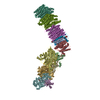
|
|---|---|
| 1 |
|
- Components
Components
-NADH-quinone oxidoreductase subunit ... , 13 types, 13 molecules ABDEFGHIJKLMN
| #1: Protein | Mass: 16474.283 Da / Num. of mol.: 1 / Source method: isolated from a natural source / Source: (natural)  References: UniProt: P0AFC3, Translocases; Catalysing the translocation of protons; Linked to oxidoreductase reactions |
|---|---|
| #2: Protein | Mass: 25097.809 Da / Num. of mol.: 1 / Source method: isolated from a natural source / Source: (natural)  References: UniProt: P0AFC7, Translocases; Catalysing the translocation of protons; Linked to oxidoreductase reactions |
| #3: Protein | Mass: 68321.945 Da / Num. of mol.: 1 / Source method: isolated from a natural source / Source: (natural)  References: UniProt: P33599, NADH:ubiquinone reductase (H+-translocating) |
| #4: Protein | Mass: 18630.049 Da / Num. of mol.: 1 / Source method: isolated from a natural source / Source: (natural)  References: UniProt: P0AFD1, NADH:ubiquinone reductase (H+-translocating) |
| #5: Protein | Mass: 49368.332 Da / Num. of mol.: 1 / Source method: isolated from a natural source / Source: (natural)  References: UniProt: P31979, NADH:ubiquinone reductase (H+-translocating) |
| #6: Protein | Mass: 100419.211 Da / Num. of mol.: 1 / Source method: isolated from a natural source / Source: (natural)  References: UniProt: P33602, NADH:ubiquinone reductase (H+-translocating) |
| #7: Protein | Mass: 36240.922 Da / Num. of mol.: 1 / Source method: isolated from a natural source / Source: (natural)  References: UniProt: P0AFD4, Translocases; Catalysing the translocation of protons; Linked to oxidoreductase reactions |
| #8: Protein | Mass: 20562.771 Da / Num. of mol.: 1 / Source method: isolated from a natural source / Source: (natural)  References: UniProt: P0AFD6, NADH:ubiquinone reductase (H+-translocating) |
| #9: Protein | Mass: 19889.551 Da / Num. of mol.: 1 / Source method: isolated from a natural source / Source: (natural)  References: UniProt: P0AFE0, Translocases; Catalysing the translocation of protons; Linked to oxidoreductase reactions |
| #10: Protein | Mass: 10852.961 Da / Num. of mol.: 1 / Source method: isolated from a natural source / Source: (natural)  References: UniProt: P0AFE4, Translocases; Catalysing the translocation of protons; Linked to oxidoreductase reactions |
| #11: Protein | Mass: 66513.633 Da / Num. of mol.: 1 / Source method: isolated from a natural source / Source: (natural)  References: UniProt: A0A1V3W1N5, NADH dehydrogenase (quinone), NADH:ubiquinone reductase (H+-translocating), NADH dehydrogenase (quinone) |
| #12: Protein | Mass: 56560.090 Da / Num. of mol.: 1 / Source method: isolated from a natural source / Source: (natural)  References: UniProt: P0AFE8, Translocases; Catalysing the translocation of protons; Linked to oxidoreductase reactions |
| #13: Protein | Mass: 52072.672 Da / Num. of mol.: 1 / Source method: isolated from a natural source / Source: (natural)  References: UniProt: P0AFF0, Translocases; Catalysing the translocation of protons; Linked to oxidoreductase reactions |
-Non-polymers , 4 types, 11 molecules 
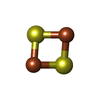
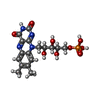




| #14: Chemical | ChemComp-SF4 / #15: Chemical | #16: Chemical | ChemComp-FMN / | #17: Chemical | ChemComp-CA / | |
|---|
-Details
| Has ligand of interest | N |
|---|
-Experimental details
-Experiment
| Experiment | Method: ELECTRON MICROSCOPY |
|---|---|
| EM experiment | Aggregation state: PARTICLE / 3D reconstruction method: single particle reconstruction |
- Sample preparation
Sample preparation
| Component | Name: Respiratory complex I from Escherichia coli - conformation 2 Type: COMPLEX / Entity ID: #1-#13 / Source: NATURAL | ||||||||||||||||||||
|---|---|---|---|---|---|---|---|---|---|---|---|---|---|---|---|---|---|---|---|---|---|
| Molecular weight | Value: 0.55 MDa / Experimental value: NO | ||||||||||||||||||||
| Source (natural) | Organism:  | ||||||||||||||||||||
| Buffer solution | pH: 6.8 Details: The buffer was used for gel filtration of protein reconstituted in lipid nanodiscs | ||||||||||||||||||||
| Buffer component |
| ||||||||||||||||||||
| Specimen | Conc.: 0.1 mg/ml / Embedding applied: NO / Shadowing applied: NO / Staining applied: NO / Vitrification applied: YES | ||||||||||||||||||||
| Specimen support | Grid material: COPPER / Grid mesh size: 300 divisions/in. / Grid type: Quantifoil R0.6/1 | ||||||||||||||||||||
| Vitrification | Instrument: GATAN CRYOPLUNGE 3 / Cryogen name: ETHANE / Humidity: 97 % / Chamber temperature: 296 K |
- Electron microscopy imaging
Electron microscopy imaging
| Microscopy | Model: JEOL CRYO ARM 300 |
|---|---|
| Electron gun | Electron source:  FIELD EMISSION GUN / Accelerating voltage: 300 kV / Illumination mode: FLOOD BEAM FIELD EMISSION GUN / Accelerating voltage: 300 kV / Illumination mode: FLOOD BEAM |
| Electron lens | Mode: BRIGHT FIELD / Nominal magnification: 60000 X / Nominal defocus max: 2200 nm / Nominal defocus min: 900 nm / Cs: 2.55 mm / Alignment procedure: COMA FREE |
| Specimen holder | Cryogen: NITROGEN / Specimen holder model: JEOL CRYOSPECPORTER |
| Image recording | Average exposure time: 3 sec. / Electron dose: 64.7 e/Å2 / Film or detector model: GATAN K3 (6k x 4k) / Num. of real images: 9122 |
| EM imaging optics | Energyfilter name: In-column Omega Filter / Energyfilter slit width: 20 eV |
- Processing
Processing
| Software |
| ||||||||||||||||||||||||||||||||||||
|---|---|---|---|---|---|---|---|---|---|---|---|---|---|---|---|---|---|---|---|---|---|---|---|---|---|---|---|---|---|---|---|---|---|---|---|---|---|
| EM software |
| ||||||||||||||||||||||||||||||||||||
| CTF correction | Type: PHASE FLIPPING AND AMPLITUDE CORRECTION | ||||||||||||||||||||||||||||||||||||
| Particle selection | Num. of particles selected: 1256734 | ||||||||||||||||||||||||||||||||||||
| 3D reconstruction | Resolution: 3.8 Å / Resolution method: FSC 0.143 CUT-OFF / Num. of particles: 21620 / Symmetry type: POINT | ||||||||||||||||||||||||||||||||||||
| Atomic model building | B value: 93 / Protocol: FLEXIBLE FIT / Space: REAL / Target criteria: Correlation coefficient | ||||||||||||||||||||||||||||||||||||
| Atomic model building |
| ||||||||||||||||||||||||||||||||||||
| Refinement | Cross valid method: NONE Stereochemistry target values: GeoStd + Monomer Library + CDL v1.2 | ||||||||||||||||||||||||||||||||||||
| Displacement parameters | Biso mean: 90.44 Å2 | ||||||||||||||||||||||||||||||||||||
| Refine LS restraints |
|
 Movie
Movie Controller
Controller









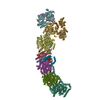

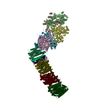
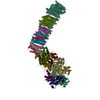
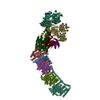
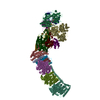
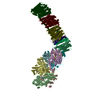
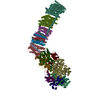
 PDBj
PDBj



















